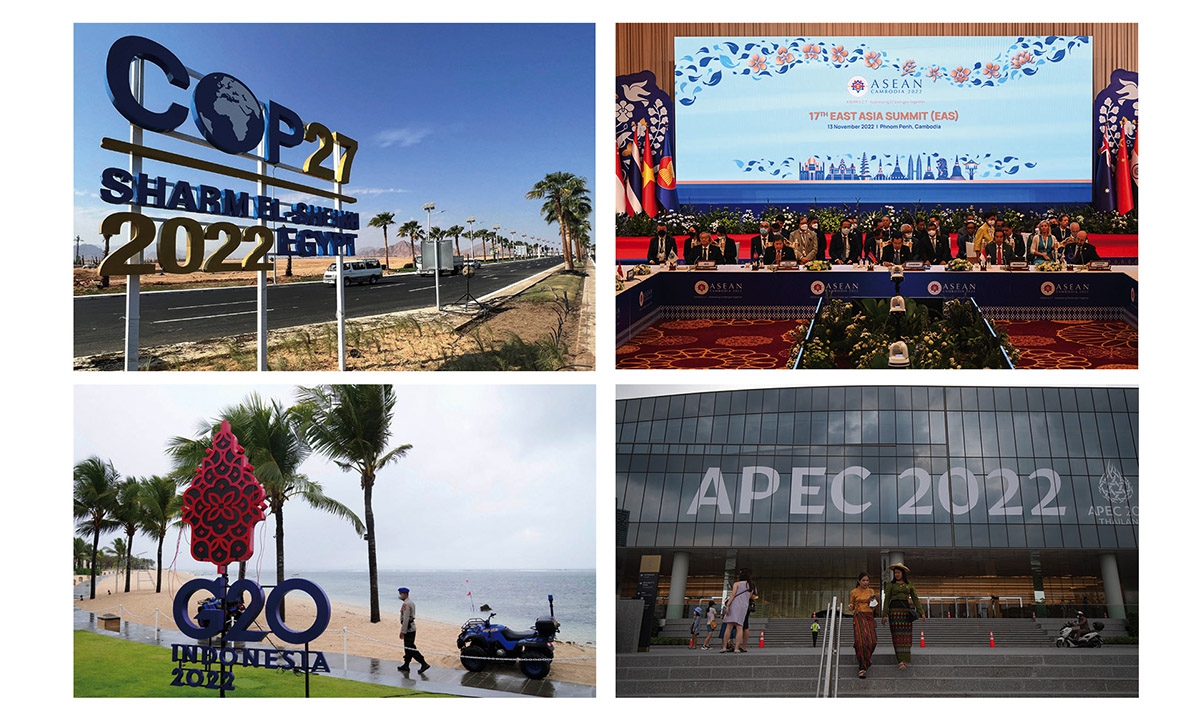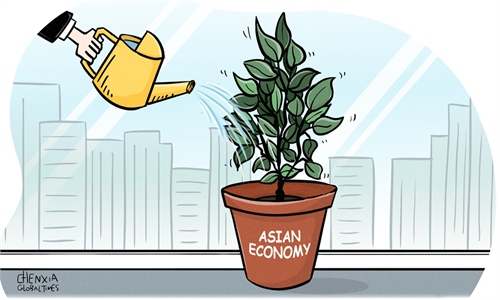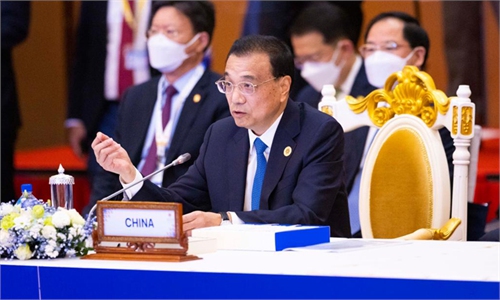
Photo: Xinhua, AFP, VCG
Editor's Note:The world today is far from being tranquil. Facing a choice of the times between solidarity and division and cooperation and confrontation, the international community expects Asia to play a leading role. ASEAN countries are successively hosting three important multilateral meetings including the ASEAN Summit and Leaders' Meetings on East Asia Cooperation, the G20 Summit, and APEC Economic Leaders' Meeting. Focusing on the "Asian Moment," the Global Times will invite several Chinese and foreign scholars to discuss how Asian countries can contribute "Asian wisdom" to the world amid unprecedented changes unseen in a century. This is the third of this series.
This month, Asia is hosting back-to-back four world summits: November 6-18 Climate summit at Sharm el-Sheikh in Egypt; November 10-13 East Asia Summit at Phnom Penh in Cambodia; November 15-16 G20 summit in Bali (Indonesia); and then, November 16-19 APEC summit in Bangkok (Thailand).
What is new is that after nearly three years of pandemic-driven disruptions and online meetings, these summits see world leaders and their delegations travelling to these cities and deliberating in person.
On the flip side, however, this return to normal also reveals how in spite of all the talk about decoupling and recasting, the world continues to face an industrialized West who still sets the tone, tenor and agenda at all summit meetings.
These summits across Asia, for instance, are bound to remain preoccupied with global shortages and price hikes for food, fuel, fertilizer and now finance - all triggered by the Ukraine crisis. Finance is the latest fourth "F" now added in face of a widely anticipated global recession reinforcing protectionist policies of Western nations.
The actual deliberations of these summits are widely suspected to be hijacked by the visible US-Russia confrontation, although Russian President Vladimir Putin is expected to join only the G20 online. But the opportunity costs of Russia delegations being harangued in these summits remain incalculable. All this not only complicates challenges for host nations but threatens to distract attention away from real issues.
Deeper questions to ask are why has West failed to bring an early end to the Ukraine war? Why has the resultant spree for weapons procurements been allowed to divert precious resources from healthcare or climate mitigation? Why energy shortages are being allowed as the new excuse for global revert to fossil fuels or for West defying their climate finance commitments? What explains this path-dependency on Western powers?
To begin with, the very institution of summits has their origins in Europe. This fashion of holding peacetime leader summits originated in 19th century Europe. The 1648 Peace Treaty of Westphalia had finally put an end to European history of religious wars and later their mercantile and industrial revolutions enabled their colonial expansions around the world. This had drifted their mutual hatred to far away territories of their hapless colonized societies.
European nations were now able to unleash destruction on these faraway lands and bargain these territories while sitting the exquisite settings of Vienna, Berlin, Paris, and London that were now the chosen venues for European summits. At least the cutlery, courtesies and conversations of summits have remained the same. Nothing changed even when they hosted anti-colonial leaders of their colonies at the same summit venues in Europe. British India's Round Table Conferences in London were British way of socializing India into so-called civilization.
Even anti-colonial gatherings were initially held in Europe. In 1927, German communist Willi Munzenberg, with support from Comintern, had initiated a League against Imperialism and Colonial Oppression by convening a meeting in Brussels that was attended by leaders of the American left plus 175 leaders, 107 out of which came from 37 colonized nations.
The two World Wars and the Great Depression of 1920 were to accelerate the wave of decolonization and transform these master-slave equations. The two decades following World War II saw emergence of a large number of new nations across Asia, Africa and Latin America. One matrix to measure this change was the membership of the United Nations that rose from 51 to 99 in its first 15 years of its existence. Asia was to see the arrival of world's largest new nations like India, China and Indonesia.
The global ramifications of this transformation were reflected in the Asian Relations Conference held in New Delhi on March-April 1947. They agreed to set up an Asian Relations Organization (ARO) and to hold two follow-up events: First, its Southeast Asian Section was to draft an ARO Convention by April 1948 and the second Asian Relations Conference was to be hosted in 1949 in China.
Only India's violent partition, first war with Pakistan, and China and Indonesia being in the last stages of their liberation struggles disrupted this momentum for Asian summitry by several years. Wars in Korea and Vietnam saw the US attempting to take over regional leadership through brute force and military alliances and "divide and rule" policy of European imperial powers.
While the North Atlantic Treaty Organization (NATO) and Australia-New Zealand-United States (ANZUS) Security Treaty survived in Europe and Australasia, Southeast Asia Treaty (SEATO) and Baghdad Pact of Central Treaty Organization (CTO) remained dysfunctional. These were replaced by US "hub-and-spokes" military alignments with Japan, South Korea, the Philippines and Singapore.
The indigenous Asian summitry was revived in April 1955 Bandung Conference of Afro-Asian nations and their five points of Bandung Spirit were to later produce world's largest ever Non-aligned Movement (NAM). Though the NAM for long remained a third pillar to reckon with, yet the Cold War succeeded in dividing Asian nations into opposite camps. It was not until the collapse of the Soviet Union which coincided with unprecedented economic rise of China that focus shifted to the emerging economies bringing Asia back to the centre.
These four summits in Asia represent that historic recognition of Asian wisdom. Asia having since emerged as the locomotive of global growth and development explains why G7 had happily co-opted six Asian nations or 12 nations of Global South in its novel G20 summits from 2008. This also explains centrality of China and India to climate change and other deliberations of global governance.
Of world top five economies today, China, Japan and India respectively occupy second, third and fifth positions. Among these India remains the fastest growing economy with promising potential. Asia together accounts for 40 percent of global manufacturing and East Asia alone accounts for over 75 percent of world's semiconductors production - a technology that has become the benchmark of technological progression.
But like old times, divisions within Asia have not disappeared altogether. These have allowed the industrialized West to continue to master over their present and future. Having done wonders in economic parameters, this calls for putting Asia's political equations in order. If Asia has to take the lead in realizing the Asian dream of what Indian Prime Minister Narendra Modi calls "no first world or third world but only one world" then Asian nations must begin by addressing their distracting mutual disputes and differences.
The author is a visiting professor at the University of British Columbia (Vancouver) and professor for diplomacy and disarmament, Jawaharlal Nehru University (New Delhi). opinion@globaltimes.com.cn



